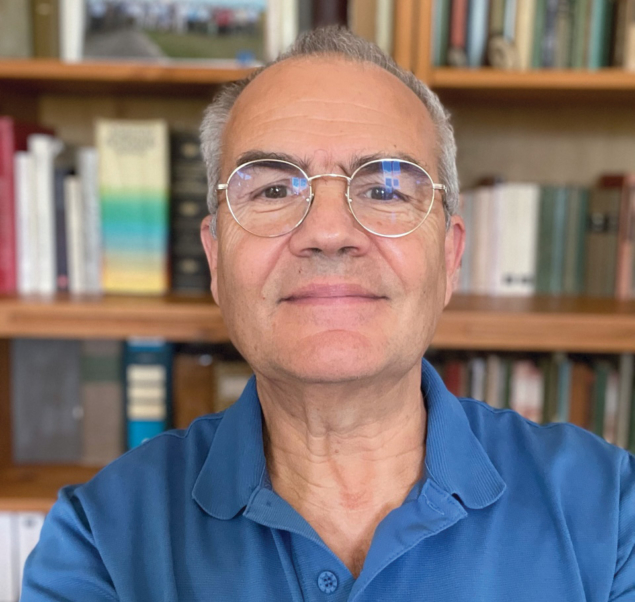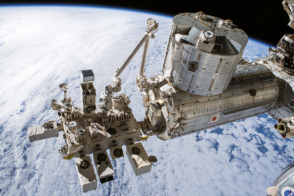As the LISA gravitational-wave observatory moves into its final design phase, Stefano Vitale describes the immense achievements so far and the challenges ahead in preparing a 2.5 million km-long interferometer in space.

What is LISA?
LISA (Laser Interferometer Space Antenna) is a giant Michelson interferometer comprising three spacecraft that form an equilateral triangle with sides of about 2.5 million km. You can think of one satellite as the central building of a terrestrial observatory like Virgo or LIGO, and the other two as the end stations of the two interferometer arms. Mirrors at the two ends of each arm are replaced by a pair of free-falling test masses, the relative distance between which is measured by a laser interferometer. When a gravitational wave (GW) passes, it alternately stretches one arm and squeezes the other, causing these distances to oscillate by an almost imperceptible amount (just a few nm). The nature and position of the GW sources is encoded in the time evolution of this distortion. Unlike terrestrial observatories, which keep their arms locked in a fixed position, LISA must keep track of the satellite positions by counting the millions of wavelengths by which their separation changes each second. All interferometer signals are combined on the ground and a sophisticated analysis is used to determine the differential distance changes between the test masses.
What will LISA tell us that ground-based observatories can’t?
Most GW sources, such as the merger of two black holes detected for the first time by LIGO and Virgo in 2015, consist of binary systems; as the two compact companions spiral into each other, they generate GWs. In these extreme binary mergers, the frequency of the GWs decrease both with the increasing mass of the objects and with increasing distance from their final merger. GWs with frequencies down to about a few Hz, corresponding to objects with masses up to a few thousand solar masses, are detectable from the ground. Below that, however, Earth’s gravity is too noisy. To access milli-Hertz and sub-milli-Hertz frequencies we need to go to space. This low-frequency regime is the realm of supermassive objects with millions of solar masses located in galactic centres, and also where tens of thousands of compact objects in our galaxy, including some of the Virgo/LIGO black holes, emit their signals for years and centuries as they peacefully rotate around each other before entering the final few seconds of their collapse. The LISA mission will therefore be highly complementary to existing and future ground-based observatories such as the Einstein Telescope. Theorists are excited about the physics that can be probed by multiband GW astronomy.
When and how did you get involved in LISA?
LISA was an idea by Pete Bender and colleagues in the 1980s. It was first proposed to the European Space Agency (ESA) in 1993 as a medium-sized mission, an envelope that it could not possibly fit. Nevertheless, ESA got excited by the idea and studies immediately began toward a larger mission. I became aware of the project around that time, immediately fell in love with it and, in 1995, joined the team of enthusiastic scientists, led by Karsten Danzmann. At the time it was not clear that a detection of GWs from ground was possible, whereas unless general relativity was deadly wrong, LISA would certainly detect binary systems in our galaxy. It soon became clear that such a daring project needed a technology precursor, to prove the feasibility of test-mass freefall. This built on my field of expertise, and I became principal investigator, with Karsten as a co-principal investigator, of LISA Pathfinder.

What were the key findings of LISA Pathfinder?
Pathfinder essentially squeezed one of LISA’s arms from millions of kilometres to half a metre and placed it into a single spacecraft: two test masses in a near-perfect gravitational freefall with their relative distance tracked by a laser interferometer. It launched in December 2015 and exceeded all expectations. We were able to control and measure the relative motion of the test masses with unprecedented accuracy using innovative technologies comprising capacitive sensors, optical metrology and a micro-Newton thruster system, among others. By reducing and eliminating all sources of disturbance, Pathfinder observed the most perfect freefall ever created: the test masses were almost motionless with respect to each other, with a relative acceleration less than a millionth of a billionth of Earth’s gravitational acceleration.
What is LISA’s status today?
LISA is in its final study phase (“B1”) and marching toward adoption, possibly late next year, after which ESA will release the large industrial contracts to build the mission. Following Pathfinder, many necessary technologies are in a high state of maturity: the test masses will be the same, with only minor adjustments, and we also demonstrated a pm-resolution interferometer to detect the motion of the test masses inside the spacecraft – something we need in LISA, too. What we could not test in Pathfinder is the million-kilometre-long pm-resolution interferometer, which is very challenging. Whereas LIGO’s 4 km-long arms allow you to send laser light back and forth between the mirrors and reach kW powers, LISA will have a 1 W laser: if you try to reflect it off a small test-mass 2.5 million km away, you get back just 20 photons per second! The instrument therefore needs a transponder scheme: one spacecraft sends light to another, which collects and measures the frequency to see if there is a shift due to a passing GW. You do this with all six test masses (two per spacecraft), combining the signals in one heck of an analysis to make a “synthetic” LIGO. Since this is mostly a case of optics, you don’t need zero-g space tests, and based on laboratory evidence we are confident it will work. Although LISA is no longer a technology-research project, it will take a few more years to iron out some of the small problems and build the actual flight hardware, so there is no shortage of papers or PhD theses to be written.
How is the LISA consortium organised?
ESA’s science missions are often a collaboration in which ESA builds, launches and operates the satellite and its member states – via their universities and industries – contribute all or part of the scientific instruments, such as a telescope or a camera. NASA is a major partner with responsibilities that include the lasers, the device to discharge the test masses as they get charged up by cosmic rays, and the telescope to exchange laser beams among the satellites. Germany, which holds the consortium’s leadership role, also shares responsibility for a large part of the interferometry with the UK. Italy leads the development of the test-mass system; France the science data centre and the sophisticated ground testing of LISA optics; and Spain the science-diagnostics development. Critical hardware components are also contributed by Switzerland, the Netherlands, Belgium, the Czech Republic, Denmark and Poland, while scientists worldwide contribute to various aspects of the preparation of mission operation, data analysis and science utilisation. The LISA consortium has around 1500 members.
What is the estimated cost of the mission, and what is industry’s role?
A very crude estimate of the sum of ESA, NASA and member-state contributions may add up to something below two billion dollars. One of the main drivers of ESA’s scientific programme is to maintain the technological level of European aerospace, so the involvement of industry, in close cooperation with scientific institutes, is crucial. After having passed the adoption phase, ESA will grant contracts to prime industrial contractors who take responsibility for the mission. To foster industrial competition during the study phase, ESA has awarded contracts to two independent contractors, in our case Airbus and Thales Alenia. In addition, international partners and member-state contributions often, if not always, involve industry.
What scientific and technological synergies exist with other fields?
LISA will look for deviations from general relativity, in particular the case where compact objects fall into a supermassive black hole. In terms of their importance, deviations in general relativity are a very close cousin of deviations from the Standard Model of particle physics. Which will come first we don’t know, but LISA is certainly an outstanding laboratory for fundamental gravitational physics. Then there are expectations for cosmology, such as tracing the history of black-hole formation or maybe detecting stochastic backgrounds of GWs, such as “cusps” predicted in string theory. Wherever you push the frontiers to investigate the universe at large, you push the frontiers of fundamental interactions – so it’s not surprising that one of our best cosmologists now works at CERN! Technologically speaking, we just started a collaboration with CERN’s vacuum group. In LISA we have a tiny vacuum volume in the region where the test masses are located, and it is full of components and cables. It was a big challenge for Pathfinder, but for LISA we definitely need to understand more. The CERN vacuum group is really interested in understanding this, so we are very happy with this new collaboration. As with LIGO, Advanced Virgo and the Einstein Telescope, LISA is a CERN-recognised experiment.
There is no other space mission with as many papers published about its science expectations before it even leaves the ground
What’s the secret to maintaining the momentum in a complex, long-term global project in fundamental physics?
The LISA mission is so fascinating that it is “self-selling”. Scientists liked it, engineers liked it, industry liked it, space agencies like it. Obviously Pathfinder helped a lot – it meant that even in the darkest moments we knew we were “real”. But in the meantime, our theory colleagues did so much work. As far as I know, there is no other space mission with as many papers published about its science expectations before it even leaves the ground. It’s not just that the science is inspiring, but the fact that you can calculate things. The instrumentation is also so fascinating that students want to do it. With Pathfinder, we faced many difficulties. We were naïve in thinking that we could take this thing that we built in the lab and turn it into an industrial project. Of course we needed to grow and learn, but because we loved the project so much, we never ever gave up. One needs this mind-set and resilience to make big scientific projects work.
When do you envision launch?
Currently it’s planned for the mid-2030s. This is a bit in the future at my age, but I am grateful to have seen the launch of LISA Pathfinder and I am happy to think that many of my young colleagues will see it, and share the same emotions we did with Pathfinder, as a new era in GW astronomy opens up.





